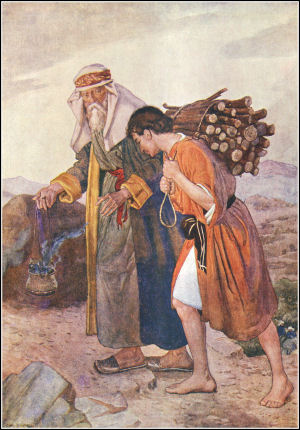 Abraham stood at the edge of the hill and at the edge of his destiny, to reference the stars again.
Abraham stood at the edge of the hill and at the edge of his destiny, to reference the stars again.Silence fell over the two gaunt figures on that lonely hill. They stood for a long while, drinking it all in. Eventually Isaac retreated and found a place to sleep, but Abraham kept his vigil, worshipping His God: standing at the edge of the hill on the threshold of his destiny.
Soon a canopy of stars crystallized the heavens into billions of sparkling jewels, strung out along a priceless necklace. Abraham had seen forms in the stars and had learnt to attach meaning to constellations and the moon. It was not the kabbalistic or mystical, magical stuff of modern day astrology, just an interpretation of the stars according to Genesis 1:14, in terms of which God said, “Let them be for signs and seasons”. That which Abraham deeply appreciated was later corrupted to become a dark gateway to the occult.
In the sky, he at least gained some idea of the immensity of his heritage, a people who would be as the stars of the heavens for multitude. I do believe that the language used in these promises, prophetically referred to the New and Old Testament churches.
The Old Testament model was like the sands, many grains in one homogenous system, bound to one mound, with no sub-groups or individual expressions. The sand spoke of Israel, that one nation that was called to be God’s oracle to the world. Israel is that precious, elect nation that has been the sharp-end of His workmanship in the world.
The New Testament is better characterized by the stars, which represent planets within their solar systems, clustered into larger galactic systems. That is a good analogy of the church. She is one universe, the term used in statistics or data modeling to describe a single aggregation or composition. Within that universal system, which we regard as the global church, are many subsystems: apostolic and denominational structures representing smaller sub-groupings or clusters of churches and church structures.
I do not believe that Abraham saw this through a hierarchical lens, but from the perspective of diversity within unity. Paul confirms that idea in Ephesians 4, where he refers to differences of operations but the same God who is all in all. In the same context, Paul said that we are no longer male or female, bond or free, Jew or Scythian, but one commonwealth,(Ephesians 3) bound together by a shared inheritance in one God, one Lord, one Faith and one Baptism (Ephesians 4). We are also bound together by a realistic commitment to keeping the unity of the Spirit in the bond of peace (Ephesians 4).
(c) Peter Eleazar at www.bethelstone.com





No comments:
Post a Comment